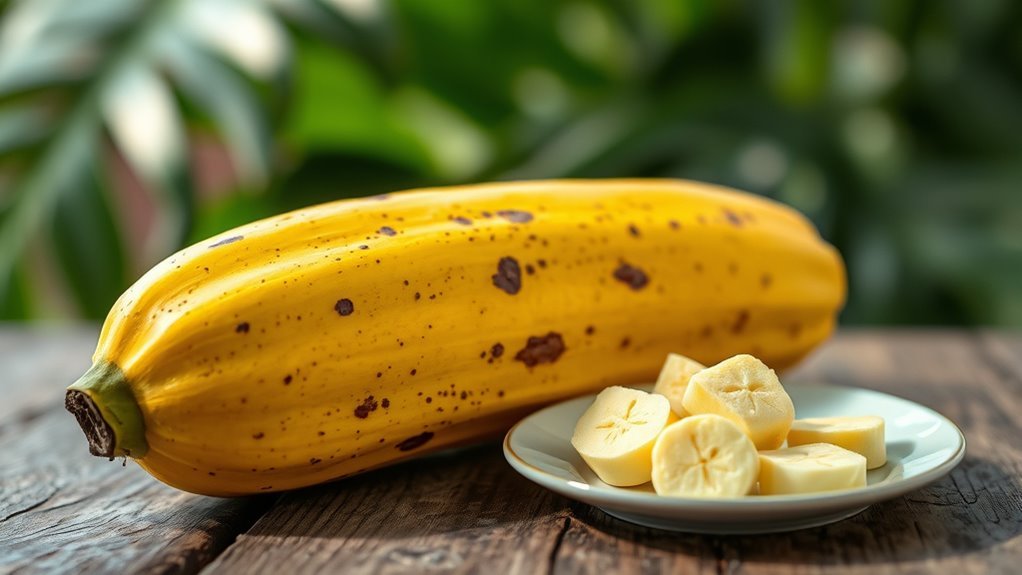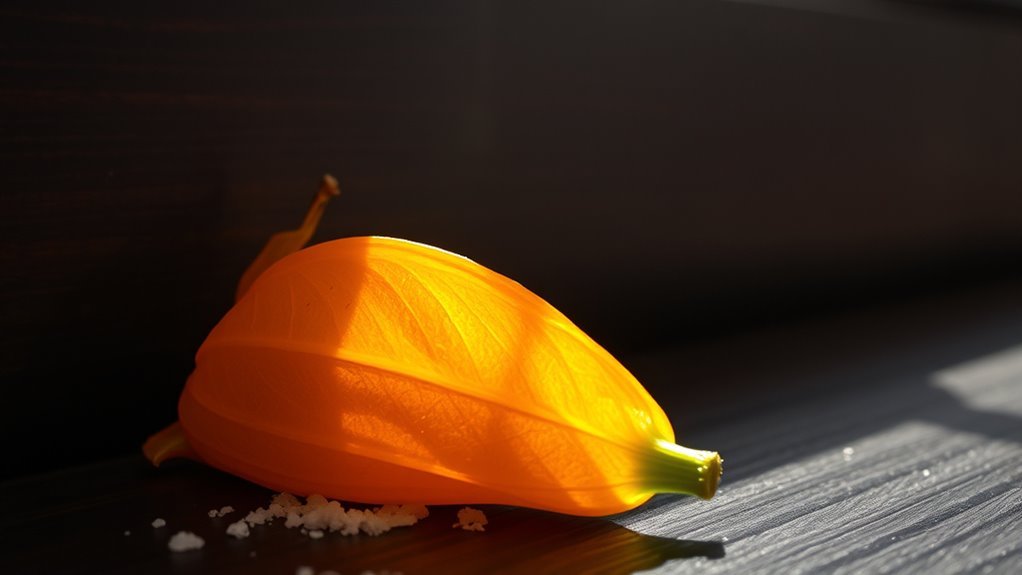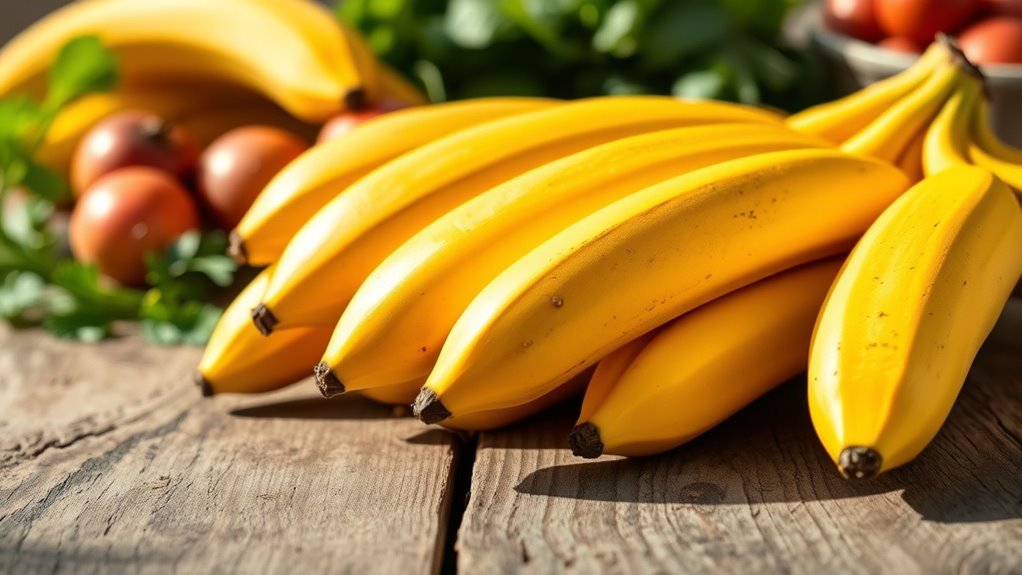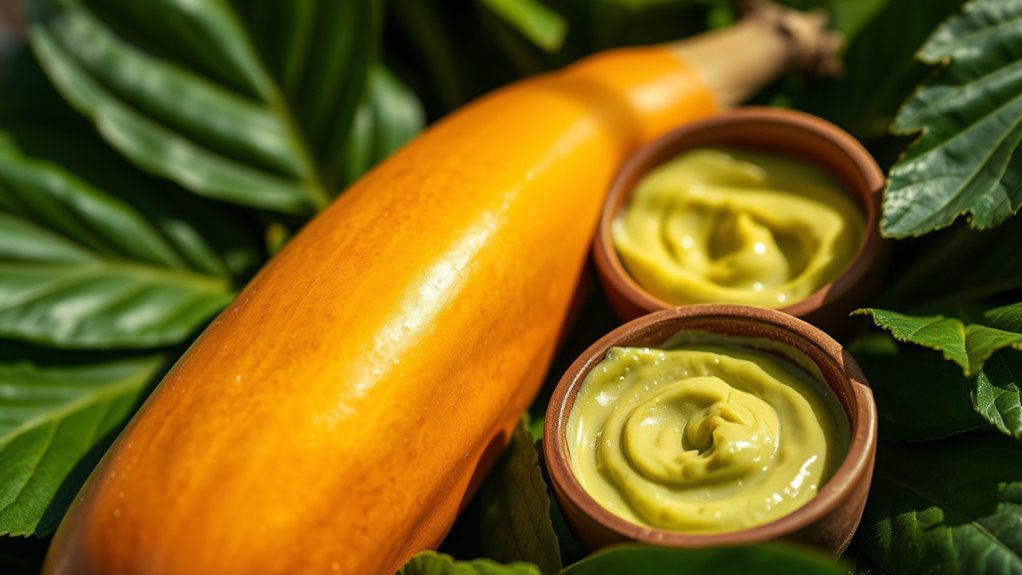No, plantains aren’t keto-friendly because they’re high in carbohydrates. Green plantains have about 31 grams of carbs per 100 grams, while ripe ones can have up to 57 grams. Incorporating even small amounts can disrupt ketosis. However, you can explore cooking methods and creative recipes to manage your carb intake, or consider low-carb alternatives like zucchini or cauliflower. Want to know more about how to enjoy plantains while staying close to your keto goals?
Nutritional Profile of Plantains

When considering the nutritional profile of plantains, it’s essential to note that they are quite different from their banana cousins. Plantains belong to various plantain varieties, which can influence their nutritional content. Generally, they’re higher in starch and lower in sugar compared to bananas, making them a versatile food choice. With regard to culinary uses, you can enjoy plantains fried, boiled, or baked, and they often serve as a staple in many tropical cuisines. They provide essential vitamins like A and C, along with minerals such as potassium. While they’re a nutritious option, understanding their profile helps you make informed dietary choices, especially if you’re exploring different culinary avenues without compromising your nutritional goals.
Carb Content and Impact on Ketosis

When considering plantains on a keto diet, it’s crucial to examine their carb content, as they are considerably higher in carbohydrates compared to other low-carb foods. This high carb level can potentially disrupt ketosis, which is the metabolic state you’re aiming for. If you’re looking for alternatives, there are several low-carb options that might better fit your dietary needs.
Plantain Carb Content
Plantains contain a significant amount of carbohydrates, which can impact your ability to maintain ketosis. Depending on the plantain varieties you choose, the carb content can vary widely. For instance, green plantains have around 31 grams of carbs per 100 grams, while ripe plantains can contain up to 57 grams. The ripeness effects are important; as plantains ripen, their starches convert to sugars, increasing the carb count. If you’re trying to stay in ketosis, it’s essential to be mindful of how much you consume. You might find that including small portions of green plantains can fit your low-carb lifestyle, but ripe ones are likely to push you over your daily carb limit. Choosing wisely is key.
Effects on Ketosis
Understanding the carb content of plantains is essential for anyone monitoring their ketosis. With about 31 grams of carbs per 100 grams, consuming plantains can greatly impact your ketosis effects. If you’re aiming to maintain a state of ketosis, incorporating plantains may not be ideal, as they could push you over your daily carb limit. This is especially true for those following strict ketogenic diets. However, there are plantain alternatives that can fit more seamlessly into your meal plan while keeping your carb intake low. Options like cauliflower rice or zucchini noodles are great substitutes that provide similar textures without jeopardizing your ketosis. Always be mindful of what you eat to enjoy the freedom of a balanced keto lifestyle.
Alternatives to Plantain
If you’re looking for keto-friendly substitutes for plantains, several options can help you maintain your carb limits without sacrificing flavor or texture. Zucchini noodles are a fantastic substitute, offering a low-carb alternative that can be used in dishes like stir-fries or pasta. With just about 2 grams of net carbs per cup, they fit perfectly into a keto lifestyle. Another great option is cauliflower rice, which has around 2 grams of net carbs per cup as well. It’s versatile and can easily absorb flavors, making it ideal for various recipes. Both alternatives provide satisfying textures and can keep your meals interesting while supporting your journey toward ketosis. Embrace these substitutes and enjoy your culinary freedom!
Comparison With Other Low-Carb Foods

While many people turn to vegetables and certain fruits to keep their carb intake low, it’s essential to compare plantains with other low-carb foods to understand their place in a ketogenic diet. Plantains, though nutrient-rich and offering various plantain benefits like fiber and vitamins, are higher in carbohydrates compared to leafy greens or cruciferous vegetables. For instance, a cup of cooked spinach has only about 6 grams of carbs, while the same serving of plantains can contain upwards of 30 grams. This stark difference emphasizes the importance of low carb comparisons. While plantains can fit into a balanced diet, if you’re strictly monitoring your carb intake, you might want to prioritize other low-carb options for best ketogenic success.
Cooking Methods and Their Effects on Carbs
When it comes to plantains, the cooking method you choose can greatly impact their carbohydrate content. Frying often leads to a higher calorie count while retaining more carbs, whereas boiling can reduce some of those carbohydrates. Baking techniques may offer a middle ground, allowing for enhanced flavor without drastically increasing carb levels.
Frying vs. Boiling Impact
Although many people enjoy plantains for their unique flavor and versatility, the cooking method you choose can considerably influence their carbohydrate content. Here’s how frying techniques and boiling methods differ:
- Frying Techniques: When you fry plantains, they absorb oil, which can lead to a higher calorie content. The frying process may also caramelize sugars, increasing perceived sweetness but not necessarily lowering carbs.
- Boiling Methods: Boiling plantains tends to retain more nutrients and can help moderate their glycemic index, potentially making them a better choice for a low-carb diet.
- Preparation Impact: The method you select ultimately affects your meal’s nutritional profile, so if you’re aiming for lower carbs, boiling might be the way to go.
Baking Techniques and Carbs
Baking plantains can be a healthier cooking method, especially for those monitoring their carbohydrate intake. Unlike frying, which can add unnecessary fats and calories, baking allows for more control over the ingredients. By using specific baking techniques, like roasting at lower temperatures, you can enhance the natural sweetness without notably increasing carb content. Additionally, you can make carb modifications by mixing plantains with lower-carb ingredients or spices, creating a delicious dish that aligns with your dietary goals. Remember, while plantains do contain carbs, the method of preparation can impact how your body processes them. Embracing baking as a technique not only supports a keto-friendly lifestyle but also offers the freedom to experiment with flavors.
Incorporating Plantains Into a Keto Diet
While plantains are often considered a staple in many diets due to their versatility and flavor, incorporating them into a keto diet can be challenging due to their higher carbohydrate content. However, you can still enjoy plantains in moderation by opting for specific recipes and preparations. Here are some ideas:
Incorporating plantains into a keto diet can be tricky, but with moderation and creativity, you can still enjoy their deliciousness.
- Plantain Chips: Bake thin slices of green plantains with olive oil and sea salt for a crunchy keto snack.
- Plantain Mash: Use ripe plantains sparingly in mashed dishes, blending them with cauliflower for a lower-carb alternative.
- Savory Plantain Pancakes: Combine mashed green plantains with eggs and spices for delicious, low-carb pancakes.
Alternatives to Plantains for Keto Followers
For those following a keto diet and looking for alternatives to plantains, there are several options that can provide similar textures and flavors without the high carbohydrate count. Here are some keto-friendly options to evaluate:
| Plantain Substitute | Carbs (per 100g) | Flavor Profile |
|---|---|---|
| Zucchini | 3.1g | Mild, versatile |
| Cauliflower | 4g | Neutral, adaptable |
| Eggplant | 6g | Slightly bitter, savory |
| Turnips | 6g | Earthy, robust |
These plantain substitutes not only fit within your carb limits but also allow you to enjoy similar dishes while maintaining your keto lifestyle. Experiment with these options and discover what works best for you!
Final Thoughts on Plantains and Keto Compatibility
Although plantains are often celebrated for their versatility and flavor, their high carbohydrate content makes them less suitable for those adhering to a strict keto diet. If you’re looking to maintain ketosis, consider the following:
Plantains’ high carb content may challenge those on a strict keto diet, so choose alternatives wisely.
- Explore Alternatives: Look for low-carb veggies like cauliflower or zucchini to replace plantains in recipes.
- Experiment with Keto Snacks: Make keto-friendly snacks using ingredients like cheese, nuts, or avocado to satisfy your cravings.
- Try Innovative Plantain Recipes: If you must use plantains, keep portions small and balance them with high-fat ingredients to minimize carb impact.
Ultimately, while plantains can be delicious, they might not fit into your keto lifestyle without careful management. Embrace the freedom to explore other options that align better with your dietary goals.
Frequently Asked Questions
Are There Any Health Benefits of Eating Plantains?
Plantains offer several health benefits, thanks to their impressive nutrition profile. They’re a good source of vitamins A and C, fiber, and potassium, which can support your immune system and digestive health. Including plantains in your diet might help regulate blood pressure and provide sustained energy due to their complex carbohydrates. However, moderation is key, as their carb content can vary, so you’ll want to balance them with other foods in your meals.
Can Plantains Be Eaten Raw or Only Cooked?
You might think raw plantains are just a culinary afterthought, but they actually pack quite a punch! While you can eat them raw, their benefits are more pronounced when cooked. Raw plantains are high in resistant starch, which can aid digestion. However, cooking methods like frying, boiling, or baking enhance their flavor and make them easier to digest. So, go ahead and experiment with both—each has its unique perks!
How Do Plantains Differ From Bananas Nutritionally?
In a nutritional comparison, plantains and bananas differ markedly. Plantains generally have a higher carbohydrate content, making them starchier and less sweet than bananas. While both provide essential vitamins and minerals, plantains are often richer in potassium and vitamin A. If you’re watching your carb intake, the differences might matter. Understanding these nuances can help you make informed dietary choices that align with your nutrition goals and lifestyle preferences.
What Are the Best Types of Plantains for Cooking?
When you think of plantains, you might picture bland, unappealing food. But both green and ripe plantains can elevate your cooking! Green plantains are starchy and perfect for frying or making tostones, while ripe plantains, with their sweet flavor, shine when baked or caramelized. Each type offers unique textures and tastes, allowing you to explore diverse culinary possibilities. Embrace the versatility of plantains; they can transform any dish into something extraordinary!
Are There Any Potential Allergens in Plantains?
When considering potential allergens in plantains, it’s crucial to know that they’re generally considered safe for most people. However, some individuals may experience allergy symptoms like itching, swelling, or digestive issues. While true plantain allergies are rare, cross-reactivity with other fruits in the same family can occur. If you’ve got a known sensitivity to similar foods, it’s wise to approach with caution and consult a healthcare professional before incorporating plantains into your diet.


